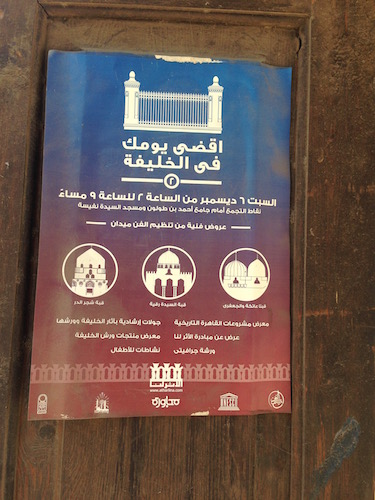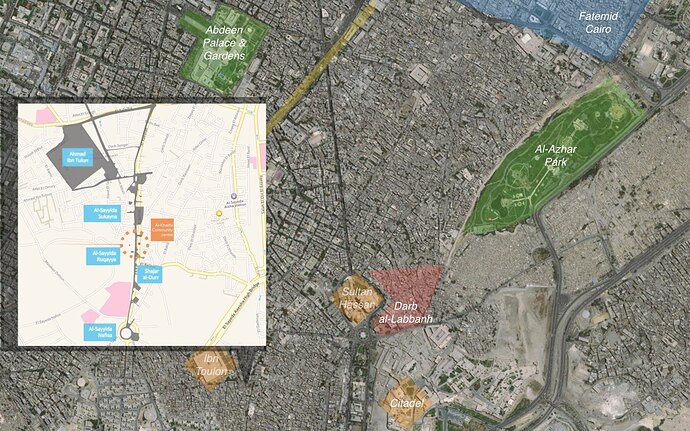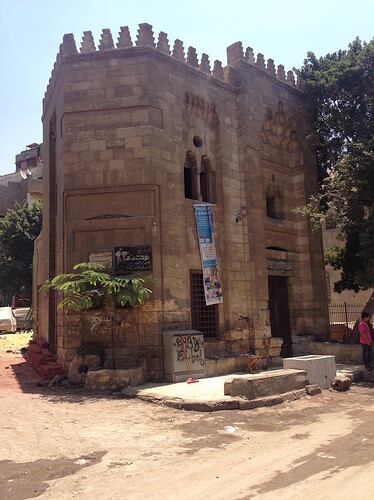I walked the small distance from Mohamed Naguib Metro Station to the Cairo’s old royal Abdeen Palace in eastern Downtown Cairo to catch a quick glance of this magnificent structure. Sunshine drowned the vast gardens surrounding the palace, a property of the Presidency of Egypt and one of its official residences. I remembered attending the various Al-Fan Midan festivals here, monthly music carnivals first launched two months after the fall of Hosni Mubarak and held until September 2014. Now, a construction crew was trimming the grass and laying a concrete path as part of an ambitious state-sponsored plan to renovate downtown Cairo headed by the Cairo governorate. As my memories subsided, I hailed a cab to travel the last mile to Ibn Toloun mosque, wherefrom I planned to walk to Megawra.
Megawra had recently moved to the al-Khalifa region in Old Cairo, a historic pocket of domes and shrines for the family of the Prophet Muhammad within wider Islamic Cairo. I entered the al-Khalifa Community Centre to meet with Dr. May al Ibrashy, who set out to explain to me what Megawra was about.
After years working as an architect and later as an architecture professor, May had started MEGAWRA as a means to promote discussions & cultural programming on the social & creative aspects of architecture outside the confines of university education. Her educational background lies in architecture and conservation. In February 2012, the initiative moved to an office located in the Ard al-Golf area of up-scale Heliopolis. MEGAWRA started there as a co-working space with a library, an exhibition space and a lecture space. It describes itself as a “platform for holistic debate on the field of architecture and urbanism with a focus on it as art, theory, praxis and cultural heritage and its role in promoting sustainability and social responsibility in the built environment.” It moved to al-Khalifa in 2014.
Organisationally, MEGAWRA the cultural space is part of a wider structure. It is operated by the Built Environment Collective, an Egyptian NGO registered in 2011 to manage some of the spaces’ activities, and the al-Khalifa Community Service centre. The lowercase Megawra Consult is an architectural firm established by May in 2014. It provides MEGAWRA with technical assistance, while handling tenders and professional consultancy and conservation projects. The scope of MEGAWRA also includes various projects and partnerships with their own unique names, such as Athar Lina, a participatory conservation initiative. Or the Ain Shams Neighbourhood Initiative, a research and development programme run by the University of Ain Shams.
In 2012 May secured funding from the Danish Egyptian Institute to start a research project in the al-Khalifa area. al-Khalifa street is one of the richest streets in Islamic Cairo in terms of the age of its heritage sites and their respective religious significance: The Shajar Al-Durr Dome, Mashhad of al-Sayyida Ruqayya, and the shrines of Atika and Ja’fri. Athar Lina, as the project is called, translates into the monuments are ours, and the first phase consisted of multiple workshops and discussions surrounding the theme of ownership and utilisation of monuments.
A common theme was identified: Most Islamic monuments are neglected and actually a menace of sorts to their communities. Overly protective heritage preservation laws prevent the community from interacting or using the monuments and carry harm in form of increasingly strict zoning, parking and adjacent construction limitations. This in turn turns the areas directly surrounding monuments into a No Man’s land; historic monuments eventually turn into garbage collection points. Such was the case with Shajar al-Durr Dome, a square-shaped burial mausoleum named after the Sultana of Egypt in the 13th century who played a crucial role in defeating the Seventh Crusade.
This first round of talk was followed by action. The second iteration of Athar Lina launched the Athar Lina School of Art and Heritage; a series of sessions around raising heritage awareness through drama, art and craft lessons. The third iteration saw the rehabilitation of the Shajar al-Durr Dome and its adjacent building; which eventually turned into the al-Khalifa Community Service centre. It is here that MEGAWRA moved to from its original Heliopolis office.
The move has many benefits: It cements the centre’s dedication to heritage conservation and care-taking through its presence; interaction with the community is institutionalised through buying up supplies locally and working side-by-side to the community served. Trust in the centre is established; while the centre gains an understanding of local dynamics. A vital component in a community used to regular rhetoric of unfilled development and restoration promises.
Al-Khalifa Community Service centre building ownership status is unclear. The building was constructed in the 1920’s as an unfinished mosque. It was converted to a community health center and operated until its closure sometime in the 1990’s; it remained closed ever since.
The keys to the building were with a nurse as ownership was shared between a clinic and a traditional tent rental business, called Farrash, who used half the space as storage. The business owner claimed his grandfather to have built the mosque back in the day; a historical cross-reference revealed that his grandfather had been the contractor of the 19th century building previously occupying the space to be which was replaced by the current unfinished mosque in the 20th century.
The custodian did not possess formal ownership papers of the building which he used as a storage space over the last years. He offered to and actually vacated the premises when confronted with a request by Megawra, and their desire to refurbish and re-open the space.
Today, the centre is run jointly by the aforementioned Built Environment Collective NGO and a committee of local community residents. With the space established, the centre started to experiment with different models of utilising the space for the communities benefit:
- Could the Athar Lina School of Art and Heritage Project be revived and contribute to community education?
- Can the al-Khalifa street realize its touristic potential through awareness campaigns documenting its rich heritage?
- Can a sustainable solution to the areas waste problem be found and implemented?
- Can it contribute to community health?
- Can it support local knowledge exchange?
“I find these experiments to be the most valuable learning resource” May said. Conservation is a costly affair, and naturally grant-dependant. No mechanisms for adaptive re-use of conserved heritage sites exist in Egypt, making self-sustained conservation a legal impossibility. As the al-Khalifa Community Service centre is not officially listed as a monument, it escapes these limitations. And it thus serves as an example for alternate modes of working, and the importance in ownership for successful projects.
Education
Today, the restored al-Khalifa Community Service centre is a safe haven for children. Previously an off-limits space surrounded by garbage, it is now open all daily for children of the community to gather and spend time in. May believes this to give the children a sense of connection to their monuments from an early age; the binding of the all-so precious childhood memories to heritage. A concept that had gradually been lost trough time. The centre also hosts daily summer classes and biweekly winter classes with the Athar Lina team teaching heritage, art, crafts, Quran, reading, writing and sports. Most classes are hosted by volunteers, a mix drawn from the community as well as from the wider MEGAWRA network.
Currently, the school is relying on an innovative model for funding its activities. It offers paid guided tours to the al-Khalifa area, including surrounding monuments such as the Ibn-Toulon and the Gayer Anderson museum, to international schools based in Cairo. These International schools host students from wealthier parents, who can afford paying a fee in exchange for these one-day field trips. May calculates that organizing ten such field-trips would cover all material and operation costs for the al-Khalifa summer school for one season.
Tourism
The al-Khalifa Community Service centre hosts regular city walks, organised walks in the al-Khalifa street which stop by all monuments and heritage sites within the area. This generates some foot-traffic to the area and tests the waters for utilising the touristic potential of the al-Khalifa street.
Yet, the rather dilapidated infrastructure situation leaves venturing to al-Khalifa a niche visit for tourists in the present time. An ongoing crowd-funding campaign hopes to raise funds to support the wider activities of the al-Khalifa Community Service centre.

Health
A main purpose to restoring the al-Khalifa Community Service centre was for it to regain the former status as a community health centre it enjoyed up till the 1990’s. Originally, a donor was found who promised to fund a salaried General Practitioner to regularly hold visitation times in a specially renovated medical room within the centre. Yet, this particular experience failed after just 4 months. The primary problem lies in the doctor coming from outside the al-Khalifa community: Issues arose around the fixed visitation times and different time perceptions of the Doctor compared to the al-Khalifa residents. Visiting during a pre-specified 4 hour window is not compatible with the perception of time amongst al-Khalifa residents, who are more flexibly minded. Trust could not be established with the Dr., whose visitation days soon went patient-less.
Two problems persist: First, the low socio-economic classification of the al-Khalifa area means that there are no local doctors who could man the health unit. Relying on doctors from outside al-khalifa is a practical necessity. Second, it is difficult to create an economically sustainable perpetual funding model. Token visitation fees collected in the previous experiment cover only a fraction of total costs; and raising them to market-prices would deter all demand for the health unit. Currently, the Medical room sits unused until a more suitable model can be implemented.
Knowledge Exchange
In perhaps the most interesting activity within the al-Khalifa centre, around 20 participants from an architectural background (academic & applied) come together every Friday for 4 months with 3 local al-Khalifa carpenters to exchange knowledge and practical skills. There is no fixed curriculum, rather participants decide collaboratively on what to learn. For many of the architects, this presented the first opportunity to work directly with wood. The activity is completely self-funded by token fees collected from participants at the beginning of the programme to cover material costs; the carpenters allow access to their tools and workshops.
As the programme progressed, around half of the architects dropped out, as well as 2 of the 3 carpenters. Failure to maintain the weekly time commitment is cited as the primary reason. The entire programme and its administration is now handled completely by the remaining carpenter, Sayyid Atallah. Sayyid is now preparing the second iteration of the Khalifa Exchange, as it is called.
I had met Sayyid 2 years ago in a round-table discussion of how to revive the Darb al-Labbana area. Darb al-Labbana lies at the south-western fringe of Historic Cairo under the Citadel, a medieval islamic fortification originally built by Salah al-Din in the 12th century, and is another hotspot of concentrated islamic heritage sites: It lies next to the Madrasa of Sultan Hassan and the al-Mosque of Rifa’i, both major visitor-attractions. It includes more than 10 registered historic monuments such as a 15th century hospital, Sufi complex and multiple 18th century residential structures with outstanding architectural ornaments.
With the government preoccupied with maximising revenue from historic sites, such a place does not really exist in Cairo. The Cairo governorate has no vision or plan for Historic Cairo. There exists no institution tasked with the improvement of Historic Cairo. This lack of vision is reflected in long-declining numbers for cultural tourism, where it is now estimated to contribute no more than 6% of touristic activity.
Back then, an architect come business entrepreneur had grand dreams of developing such under-utilised areas, and surrounded himself with like-minded youths. Sayyed, who was born in the area surrounding al-Khalifa, was drawn by a deep desire to work for his community. He had a decade of experience working in carpentry, and a stable income stream therefrom. Yet, the dilapidated state of his physical surroundings left him yearning for more. He started attending meetings, and eventually took part in a workshop sponsored by Athar Lina, and thus came across May, MEGAWRA and the al-Khalifa Community Service centre.
Reflection
As I left the al-Khalifa area, I started comparing the restoration of the al-Khalifa Community Service centre with the restoration of the Abdeen Gardens. Both represent two different approaches: The bottom up approach of May lies in stark contrast to the Cairo Governorate led project. The al-Khalifa Community Service centre is slowly amassing more and more community members in its activities, such as carpenter Sayyed Attallah, and is pursuing activities that are at their heart people-centric. Abdeen Gardens meanwhile are a potent symbol of the states’ pursuit of beautification, a policy born out of rejection of the dilapidated state of most of the cities infrastructure. Yet, implementing the policy coincided with the decline, and eventual ban, of the Al-Fin al Midan festival. The same questions Megawra hopes to discuss posed themselves: Who owns these public places, be they monuments or gardens? Who protects them? Who improves them? Who puts them at risk?
I wondered wether Sayyed could ever be part of the downtown Cairo revival project the way he became part of the al-Khalifa Community Service centre.
Edit 1: Incorporated some detail changes suggested by the Interviewee.




 I visited MEGAWRA and some of its activities in Khalifa within a university excursion to Cairo … It was a big group of mixed nationalities and backgrounds so the discussion afterwards was rather rich … personally I find the amount of work that people invest there truly inspiring … but questions of management of the upgraded spaces post the restoration always pop up … how sustainable your work would be under every possible management models? for instance the playground built on a cleared garbage dump site was handed to a governmental department (as far as I remember) and children were charged entry fees to play in it… So on one hand I would say that place is a much needed leisure space in such a dense neighborhood but on the other hand unless it’s managed in an inclusive way, the efforts would be lost and only few who will enjoy this “public” space … and that’s a big challenge in Egypt … the most successful projects big or small are usually run in a way that contradict its original goals.
I visited MEGAWRA and some of its activities in Khalifa within a university excursion to Cairo … It was a big group of mixed nationalities and backgrounds so the discussion afterwards was rather rich … personally I find the amount of work that people invest there truly inspiring … but questions of management of the upgraded spaces post the restoration always pop up … how sustainable your work would be under every possible management models? for instance the playground built on a cleared garbage dump site was handed to a governmental department (as far as I remember) and children were charged entry fees to play in it… So on one hand I would say that place is a much needed leisure space in such a dense neighborhood but on the other hand unless it’s managed in an inclusive way, the efforts would be lost and only few who will enjoy this “public” space … and that’s a big challenge in Egypt … the most successful projects big or small are usually run in a way that contradict its original goals.